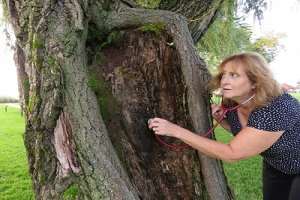By Sarah Rautio
Michigan State University Extension receives many inquiries through its MSU Extension Lawn and Garden Hotline about how home gardeners should deal with diseases, pests and weather conditions that negatively affect their lawns, plants, shrubs and trees. Plants can “get sick” from a virus, a bacteria, fungi, an insect and/or an environmental stressor, such as prolonged heat. When this happens, home gardeners seek a “plant prescription” to help heal the plant, such as “remove the pest and/or diseased parts” and “water during drought conditions.” When a person gets sick, their prescription may include similar recommendations, such as surgery and increased liquid consumption. Both these approaches are examples of trying to mitigate the damage that has already been done but there is another approach. By practicing “preventative medicine” sometimes the damage can be avoided entirely.

The American College of Preventative Medicine defines preventative human medicine as a means “to protect, promote, and maintain health and well-being and to prevent disease, disability, and death.” In other words, the healthier a person is in the first place, the more likely it is that they can prevent and combat disease. MSU Extension helps people stay healthy and reduce their risk of disease by providing free and low-cost health programs throughout Michigan.
Interestingly, this same concept can be applied to plants: the healthier the plant is in the first place, the more likely it is that it can prevent and combat disease. In fact, the actual steps to prevent and combat disease in humans are remarkably similar to those that work for plants, too, as described below:
- Ensure plants receive adequate nutrients from the soil by Building Smart Soils.
- Ensure plants receive adequate moisture by supplementing during dry conditions, adding compost to hold moisture around roots, or mulching at the surface to conserve soil moisture. If your soil is naturally dry or sandy, opt for more drought-tolerant plants.
- Place plants in the environment best suited to their temperature, light and soil needs. Seek Smart Plants or native selections that are better suited to the local environment.
- Properly space plants. Many diseases easily spread when plants are too close to one another. Crowding traps moisture, promoting disease-causing fungi.
- Keep a plant’s environment clean by removing fallen plant debris that can harbor disease agents (e.g. fungal spores, overwintering insect eggs), especially if plants were recently diseased. Throw away or burn diseased debris.
- Remove diseased portions of plants, shrubs and trees as soon as possible to prevent the spread of disease. Throw away or burn diseased pieces.
- Increase diversity: strive to have a variety of plants, shrubs and trees. A pest/disease often focuses on one single plant species. With many of the same plant species, a pest will become more numerous and can cause greater overall damage to a landscape.
- Increase the numbers of “beneficial” insects that feed on pests in your landscape. Try planting a Smart Flower Border to attract beneficial insects. Reduce the use of pesticides and practice targeted forms of pest management (IPM) to minimize loss to beneficial insects.
- Practice Smart Law Care to create a healthier lawn that reduces the risk of pests.
Source: msu.edu